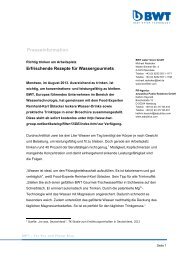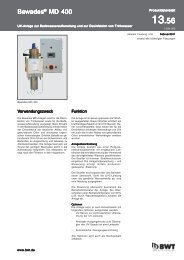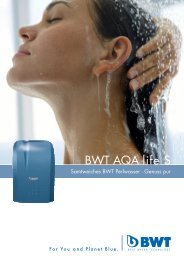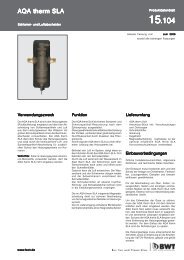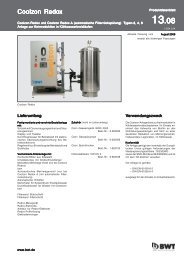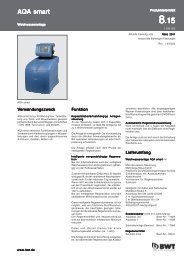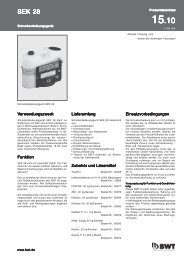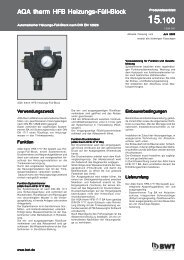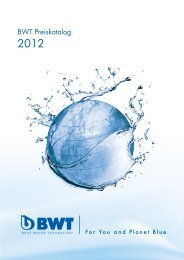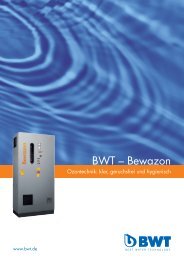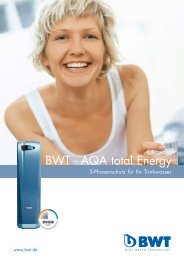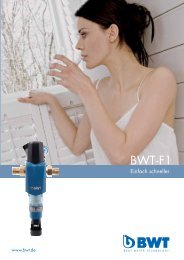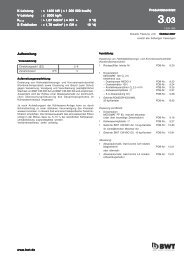Rondomat M - bei BWT Wassertechnik GmbH
Rondomat M - bei BWT Wassertechnik GmbH
Rondomat M - bei BWT Wassertechnik GmbH
Erfolgreiche ePaper selbst erstellen
Machen Sie aus Ihren PDF Publikationen ein blätterbares Flipbook mit unserer einzigartigen Google optimierten e-Paper Software.
Installation Installation conditions<br />
conditions<br />
Observe all applicable installation regulations,<br />
general guidelines, hygiene requirements and technical<br />
specifications.<br />
Water softeners may not be installed in water<br />
supply systems that provide water for fire extinguishing<br />
purposes.<br />
The pipeline network must be flushed before the<br />
unit is installed.<br />
The hard water to be fed into the unit must always<br />
meet the specifications of the Trinkwasserverordnung<br />
(German Drinking Water Ordinance) or<br />
EU Council Directive 98/83/EC. The total dissolved<br />
iron and manganese may not exceed 0.1 mg/l. The<br />
hard water to be fed into the unit must always be<br />
free of air bubbles. If necessary, a bleed device<br />
must be installed.<br />
Continuous operation of the water softener with<br />
water containing chlorine or chlorine dioxide is<br />
possible if the concentration of free chlorine/chlorine<br />
dioxide does not exceed 0.5 mg/l.<br />
However, continuous operation with water containing<br />
chlorine/chlorine dioxide causes the ion<br />
exchange resin to age prematurely. A water softener<br />
reduces the concentration of free chlorine<br />
and chlorine dioxide. In other words, the concentration<br />
in the outflow of a water softener is generally<br />
considerably lower than in the inflow.<br />
The unit should be sized in such a way that<br />
regeneration is necessary at least once a day<br />
based upon the throughput. If water consumption<br />
is reduced, e.g. during holidays, a shut-off device<br />
must be fully opened for at least 5 minutes before<br />
water can be used again (DIN 1988 parts 4 and 8).<br />
Use corrosion-resistant pipe materials for installation.<br />
Pay attention to corrosion-causing chemical<br />
properties when different pipe materials are combined<br />
(mixed installation), even in the direction of<br />
flow upstream of the water softener.<br />
A protective filter must be installed in the direction<br />
of flow no further than 1 1 m m upstream from the unit.<br />
The filter must be functional before the water<br />
softener is installed. This is the only way to ensure<br />
that dirt and corrosion products do not enter the<br />
water softener.<br />
You must check whether a mineral substance<br />
metering device needs to be installed downstream<br />
from the water softener for the purpose of preventing<br />
corrosion.<br />
0000<br />
Σ m m3<br />
Installation diagram<br />
When installing the water softener, select a location<br />
where the unit can easily be connected to the water<br />
supply network. A connection to the sewage<br />
system (at least DN 50), a floor drain and a<br />
separate power supply (230 V/50 Hz) must be<br />
located in the immediate vicinity.<br />
The emission of interference (voltage peaks, highfrequency<br />
electromagnetic fields, interference<br />
voltages, voltage fluctuations etc.) by the surrounding<br />
electrical systems may not exceed the<br />
maximum values specified in EN 61000-6-4.<br />
The rated mains power (230 V/50 Hz) and the<br />
required operating pressure must be present at all<br />
times. A separate means of protection against a<br />
shortage of water is not provided and must be<br />
installed on site if desired.<br />
If no floor drain and/or structural waterproofing<br />
compliant with DIN 18195-5 is present, a separate<br />
safety device (e.g. a hydrostop) must be used.<br />
The installation site must be protected from frost<br />
and be kept free of chemicals, paints, solvents and<br />
fumes, and the ambient temperature must not be<br />
too high.<br />
If the softened water is intended for human consumption<br />
as defined in the Trinkwasserverordnung<br />
(German Drinking Water Ordinance), the<br />
ambient temperature must not exceed 25 °C.<br />
If the softened water is intended for technical<br />
purposes only, the ambient temperature must not<br />
exceed 40 °C.<br />
The hose attached to the overflow of the brine<br />
container and the flushing water hose must be<br />
routed at an incline to the sewage system or<br />
connected to a pump. According to DIN 1988, the<br />
flushing water hose must be secured at a distance<br />
of at least 20 mm from the highest possible waste<br />
water level (unimpeded drainage).<br />
If flushing water is fed into a pump, it must be<br />
designed for a water volume of at least 2 m 3 /h or<br />
35 l/min. If the pump is used for other units<br />
concurrently, it must be sized larger appropriate to<br />
the units’ water output volumes.<br />
The pump must be salt-water resistant.<br />
The unit’s maximum operating pressure must<br />
never be exceeded (see technical specifications).<br />
If the network pressure is higher, a pressure<br />
reducer must be installed upstream from the unit.<br />
The unit requires a minimum operating pressure<br />
to function (see tech. specifications).<br />
During pressure fluctuations or surges, the sum of<br />
the pressure surge and the standing pressure is<br />
not to exceed the nominal pressure. The positive<br />
pressure surge must not be greater than 2 bar and<br />
the negative pressure surge must not be less than<br />
50% of the self-adjusting flow pressure (see DIN<br />
1988 part 2.2.4).<br />
Non-compliance Non-compliance with with the the installation installation conditions conditions<br />
conditions<br />
voids voids the the the warranty warranty<br />
warranty<br />
<strong>BWT</strong> provides no warranty or guarantee if the unit<br />
fails or if the capacity becomes deficient due to<br />
incorrect material selection/combination, floating<br />
corrosion products or iron and manganese deposits,<br />
or any resulting damage thereof.<br />
Functional Functional and and and warranty warranty conditions<br />
conditions<br />
Water softeners and ion exchange units require<br />
regular functional monitoring, maintenance and<br />
replacement of important parts after certain intervals.<br />
The amounts of regenerative necessary are subject<br />
to the level of consumption, which depends on<br />
operating conditions.<br />
Water softeners must be cleaned regularly and<br />
also disinfected if necessary.<br />
See the installation and operating instructions for<br />
the maintenance intervals.<br />
We recommend that you enter into a maintenance<br />
agreement.<br />
> > > 20 20 20 mm mm<br />
mm<br />
Flushing water connection and overflow



